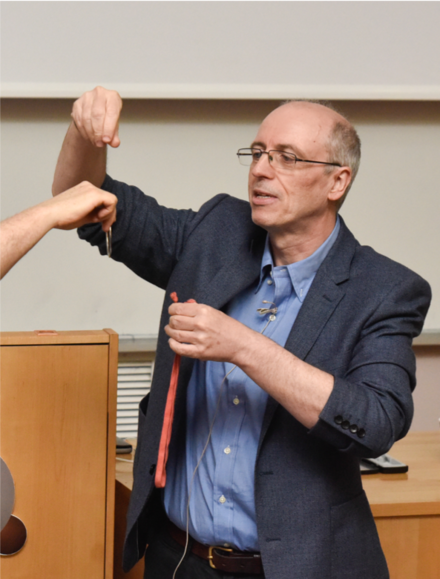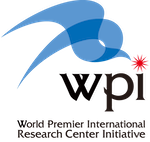Magic, Self-assembling Knots Presented by Dr. David Leigh During WPI-SKCM² Seminar Visit
A few minutes into what seemed like a normal scientific presentation, David Leigh, Royal Society Research Professor & Sir Samuel Hall Professor of Chemistry at the University of Manchester, stepped to the front of the WPI-SKCM2 seminar room. Eyes shifted from the PowerPoint slides to Leigh leisurely pulling torn fragments of a newspaper from his pocket as he discussed the various components involved in creating a newspaper. Then, unexpectedly, with a swift gesture, he shook the shredded pieces of paper, which magically transformed into a whole, complete newspaper as Leigh triumphantly announced, “self-assembly!” Leigh, known for incorporating magic tricks into his seminars and lectures, aimed to illustrate that his lab uses self-assembling compounds to synthesize knots, woven materials, as well as machines at the molecular level.
“Knotted structures are abundant at the molecular level in nature. Biology must have reasons for this,” Leigh asserted. Researchers would like to be able to create such knots in order to understand the effects of knots in nature. However, until quite recently, synthesizing these structures remained out of reach. For example, the synthesis of the first trefoil knot in 1989 was groundbreaking, and as recently as 2012, new examples were being published in the highly prestigious journal Science. So, Leigh’s group embarked on creating molecular knots using the technology they had developed to create molecular machines, which allow them to control how molecular strands are threaded and linked.
Throughout his 50-minute seminar, Leigh demonstrated how far the field has progressed by showing different projects and discoveries from his lab, such as a continuous loop with 8 non-alternating crossings made from 192 atoms, which has the Guinness World Record for being the tightest knotted structure in the world. To create such complex knots, Leigh’s group follows an investigation process of design, investigation, problem-solving, observation, luck, discovery, and finally, understanding. Leigh noted, “Almost always, all of our time is spent solving problems because our designs don’t actually work … Then once you’ve solved this problem, you’ve discovered something new, and your understanding of how to tie more complicated knots has improved which then allows you to design syntheses of more complicated structures.”
The impressiveness of the compounds was furthermore illustrated by professional quality animations that made it feel more like watching a show on National Geographic rather than sitting in a university lecture hall. One such animation detailed the creation of a molecular woven material – the process of self-assembly, analysis of the material’s thickness, and using the material as a molecular filter all came alive on screen. An in-depth version of the video can be seen here: https://www.youtube.com/watch?v=TRR5pDYw8og. It is rare for a scientist to create animations of that quality. But Leigh, who works with professional artists, said that he enjoys working with creative people to create these exceptional representations of the science done in his lab.
Leigh ended his presentation by stating, “The introduction of knotting and weaving, of course, revolutionized the lives of prehistoric humans. Being able to make nets allowed humans to catch fish and feed themselves; Being able to tie axe heads onto staffs enabled them to make weapons to kill and hunt animals; Being able to weave allowed them to clothe themselves and go and live in different climates. Knotting and weaving revolutionized the history of humankind. Can nanoscale knotting and weaving also have an impact? We will all have to wait and see, and that’s probably what your center will lead the way on.” The researchers at WPI-SKCM2 are working hard to accomplish this significant task.



